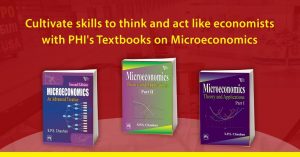Just as money is at the core of every activity, so is the economics behind all of them. What goods and services we buy and what price we pay for them and when; what quality and quantity we get in return; what amount we invest and in what; what goods and services we produce for income; how do we distribute revenue realized among factors of production; and, what we consume and how are some of the basic decisions we have to make sooner or later. Our satisfaction or dissatisfaction and success or failure all depend on such decisions whether they were good ones or bad ones. While some of us happen to be impulsive buyers and investors; others, undecided; and a few, rely on high price as an indicator of quality. There are also a few who buy whatever is cheapest due to paucity of funds.
The case with the government is also somewhat the same. Some governments introduce rationing for the weaker sections, reserve jobs for them, levy direct taxes on well-to-do-citizens, indirect or goods and services taxes on products, grant subsidies to producers for production of essential goods and services, and also resort to imports to meet the domestic demand of such essentials. Every government encourages domestic production for self-reliance and self-sufficiency, as far as possible. They also tend to protect domestic producers’ interests by introducing tariff and non-tariff barriers on luxuries so that cheaper foreign luxuries may not siphon out domestic incomes or force premature shut down on domestic industries that suffer from higher production costs of relatively lower product quality in their infancy stages. Apart from such issues, governments have to provide certain amenities, which require funds to raise which, they levy direct and indirect taxes, the extent of which, depends on the consumer and producer surpluses. All these issues are intertwined and interdependent. They can’t be viewed in isolation. That makes economics a complicated discipline. All the activities we undertake are economic activities. No one can make rational decisions easily without treating them in totality. This calls for the clarity of the basic concepts.
Microeconomics – An Advanced treatise by Prof. S.P.S. CHAUHAN (PHI) is a comprehensive self- sufficient attempt, which the author claims to provide the readers a clear insight not only into the basics but also to the heights at which they can develop independent and confident opinions about economic activities and affairs including rationing, taxation, subsidies, supplementary incomes, consumer and producer surpluses, sharing of GST between buyers and sellers, price floors and price ceilings with their consequences on production and consumption, diversification of investment portfolios, allocation and re-allocation of resources, optimality in production and consumption by individual producers and consumers, leisure and labour preferences of workers, indifference curve approaches to all these issues, with concrete numerical case-lets, costs and prices, market forms, monopoly power and its regulation, oligopolistic games, problems of efficiency , employment growth and development, econometric estimation of economic functions, pricing in practices, decisions theories, investment decisions of individuals and capital asset pricing, linear programming, input-output decisions, theories of international trade, externalities and public goods, and , all the concepts essential to make the a reader a confident economist. The book is based on the inspiration of Prof. (Dr.) Manab Adhikary, (ex-Dean, FMS, University of Delhi), an internationally renowned economist with multiple international awards, who along with the author of the book, shares the same ideology that economics has no limits and no limitations. It can’t be limited to any syllabus or topics.
In Dr.Manab Adhikary’s opinion, it must be developed from the ground level and must reach the highest orbits with all that makes its command simple, analytical and deterministic. There must be no uncertainty, but only the calculated risks.
The author has intended to explain the concepts in very simple language, without resorting to the jargon of vocabulary which many authors resort to and inconsequence, encourage cramming, not grasp and command on the discipline. The third edition of the author’s book is in progress. It contains excel spread-sheets for simple econometric calculations by researchers. Try and see for yourself
Available in e-book and print book formats: www.phindia.com.
Use promo code ???@?????? & ??? ??% off. This promo code is valid till ?? ??????? ???? midnight.
